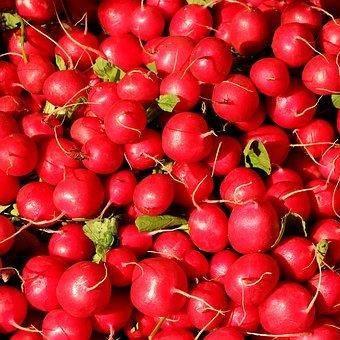Radishes
Radish, a member of the crucifer family, is a coolseason, fastmaturing, easy-to-grow vegetable. Garden radishes can be grown wherever there is sun, even on the smallest city lot.
Searcy, Ark. –
Radishes have been cultivated for over 2,000 years but are still close to their ancestral type, often reverting to a form with a dry, woody root. There is no doubt the species is indigenous in the temperate regions of the Old World. It has been cultivated in gardens from China and Japan to Europe since earliest times. It is difficult to pinpoint its specific place of origin. Radishes are grown all over the world today and are highly esteemed because of their pungent flavor.

Radish, a member of the crucifer family, is a cool-season, fast-maturing, easy-to-grow vegetable. Garden radishes can be grown wherever there is sun, even on the smallest city lot. They usually grow best in the spring, but some late-maturing varieties can be planted for summer use. Winter radishes are slower to develop than spring radishes, but they grow considerably larger, remain crisp longer and are usually more pungent.
Plant spring radishes from late winter to mid-spring. Make successive plantings of short rows every 10 to 14 days. Spring radishes can also be planted in late winter in a protected cold frame, window box or container in the house or on the patio. Late maturing varieties usually withstand heat better than the early-maturing varieties and are recommended for late spring planting for summer harvest. Winter radishes require a much longer time to mature than spring radishes and are planted at the same time as late turnips. Recommended spring and fall radishes are: Cherry Belle, Easter Egg Blend II, China Rose, French Breakfast or D’Avigon. Summer Radishes: April Cross Hybrid, Champion, and White Icicle.
Sow seed 1/4 to 1/2 inch deep. Thin spring varieties to 1/2 to 1 inch between plants. Thin winter radishes to 2 to 4 inches or even farther apart to allow for proper root development.
Radishes grow well in almost any soil that is well prepared, fertilized before planting and has adequate moisture. Slow development makes radishes hot in taste and woody in texture.
Pull radishes when they are of usable size (usually 1 to 1 1/2 inches) and relatively young. Radishes remain edible for only a short time before they become pithy (spongy) and hot.
Common Problems
Root maggots may tunnel into radishes. Apply a suggested soil insecticide before the next planting. Flea beetles and aphids may damage the leaves.
When damage exceeds 10 percent of leaf area, apply an approved method of insect control.
Frequently Asked Questions
Q. What causes my radishes to crack and split?
A. The radishes are too old. Pull them when they are young and small.
Q. Why do my radishes grow all tops with no root development?
A. There may be several reasons: seed planted too thick and plants not thinned, weather too hot for the spring varieties that do best in cool temperatures and too much shade. Radishes will not enlarge properly when forced to mature during temperatures above 80 degrees F.
Q. What are winter radishes and how do they differ from regular garden radishes?
A. Winter radish varieties produce large roots which may be round or elongated and white, red or black. ‘China Rose’ and ‘Round Black Spanish’ are two winter cultivars. They require a long season for full growth. The roots may be eaten raw with vinegar or cooked like turnips. The flavor of winter radishes is usually pungent and the texture more fibrous and less crisp than common garden radishes.
Q. Sometimes my radishes have a hot, bitter flavor. What is the problem?
A. Off-flavored radishes are caused by planting at the wrong time or poor cultural practices, such as low fertility or low moisture, resulting in slow growth. For highest quality, radishes should grow fast. Maintain adequate fertility and good soil moisture conditions to encourage fast growth. Radishes that are too old taste hot.
For more information check out Home Gardening Series: Radishes
###
By Sherri Sanders
County Extension Agent - Agriculture
The Cooperative Extension Service
U of A System Division of Agriculture
Media Contact: Sherri Sanders
County Extension Agent - Agriculture
U of A Division of Agriculture
Cooperative Extension Service
411 No Spruce Searcy AR 72143
(501) 268-5394
ssanders@uada.edu
The Arkansas Cooperative Extension Service is an equal opportunity institution. If
you require a reasonable accommodation to participate or need materials in another
format, please contact your County Extension office (or other appropriate office)
as soon as possible. Dial 711 for Arkansas Relay.
Pursuant to 7 CFR § 15.3, the University of Arkansas System Division of Agriculture
offers all its Extension and Research programs and services (including employment)
without regard to race, color, sex, national origin, religion, age, disability, marital
or veteran status, genetic information, sexual preference, pregnancy or any other
legally protected status, and is an equal opportunity institution.